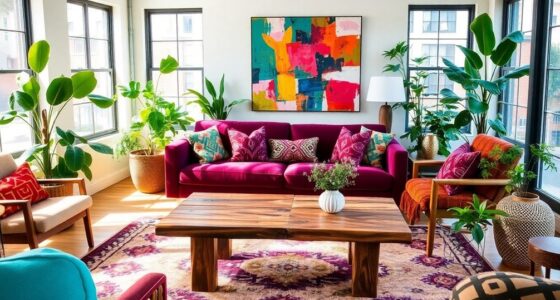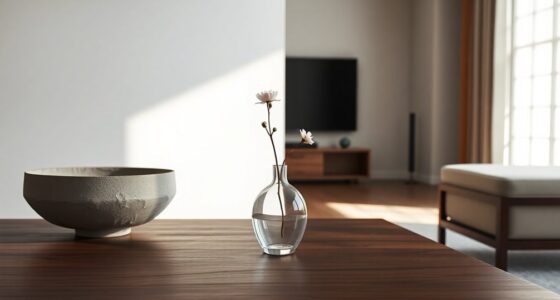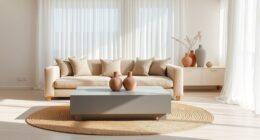If you're drawn to the vibrant and playful elegance of the 1960s, you'll love its unique interior design style. Influenced by pop culture icons and space exploration, this era showcases bold patterns, vivid colors, and innovative materials like plastic and laminate. You can expect to see iconic pieces such as the Eames Lounge Chair and the Tulip Table, featuring smooth lines and organic forms. Rugs and wall treatments also play a vital role in enhancing the ambiance. By embracing some of these elements, you can capture that nostalgic vibe in your own space. There's much more to explore about this exciting era.
Key Takeaways
- The 60s interior design embraced vibrant colors, bold patterns, and playful forms, reflecting the era's pop culture and psychedelic influences.
- Iconic furniture pieces like the Eames Lounge Chair and Egg Chair showcased innovative materials and organic shapes, defining the mid-century aesthetic.
- Rugs and transformative wall designs featured geometric patterns and retro motifs, enhancing room cohesion and adding visual interest to spaces.
- The era emphasized functionality, with multifunctional furniture and minimalist design principles that prioritized comfort and practicality in living spaces.
- Lasting influences from 60s design continue to shape modern interiors, emphasizing clean lines, human-centered design, and the integration of indoor and outdoor spaces.
Key Influences of the 60s

As you delve into the key influences of the 60s, you'll find that this vibrant decade was shaped by a mix of pop culture, space-age inspiration, and post-war optimism.
The Beatles and The Rolling Stones were at the forefront, encouraging playful design with bold patterns and vibrant colors. Music festivals promoted communal living spaces infused with energetic vibes, while psychedelic art seeped into interior design, adding colorful prints. During this time, many textile artists began experimenting with mixed media elements that complemented the overall aesthetic.
Meanwhile, the excitement of space exploration inspired sleek, futuristic aesthetics, leading to innovative materials and geometric patterns. Post-war optimism fueled a desire for self-expression, pushing families to embrace daring designs that reflected newfound freedom. This era also saw an embrace of vivid colours that became a hallmark of 1960s interiors.
These elements combined created a unique and dynamic backdrop for mid-century interior design.
Defining Features of 60s Design
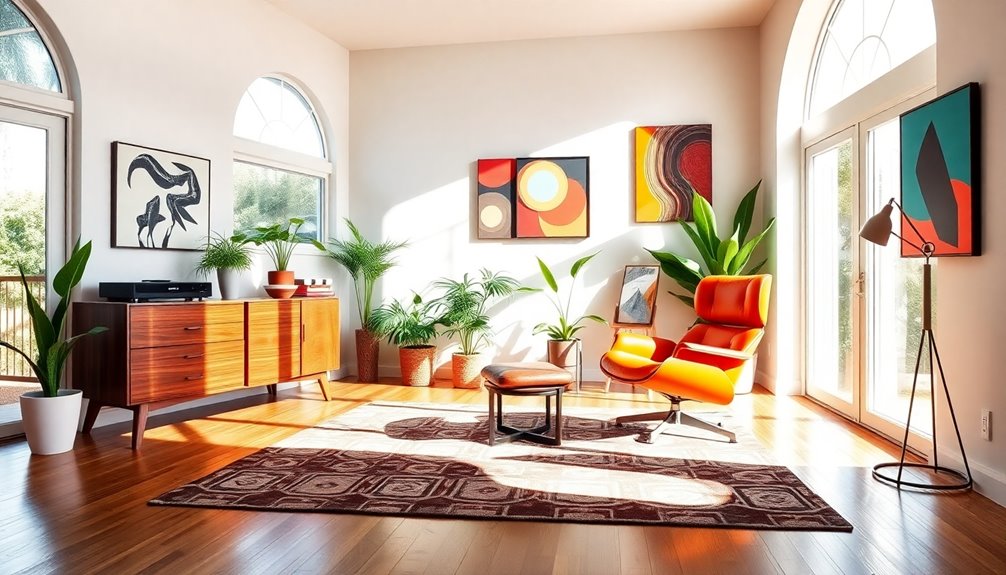
The vibrant influences of the 60s shaped a distinct design aesthetic that stands out even today. You'll notice vivid colors like bright oranges, yellows, greens, and purples creating eye-catching combinations. Primary colors complemented each other beautifully, while warm tones added a cozy feel to interiors. Innovative materials like plastic and laminate brought a futuristic vibe, with molded furniture featuring rounded edges that spoke to the era's organic forms. The 1960s embraced statement lighting, such as lava lamps and Sputnik chandeliers, became focal points, enhancing the psychedelic atmosphere. Curved lines and wild fabrics showcased the playful spirit of the time, inviting you into a space that was both stylish and comfortable, embodying the essence of mid-century modern design.
The Role of Rugs
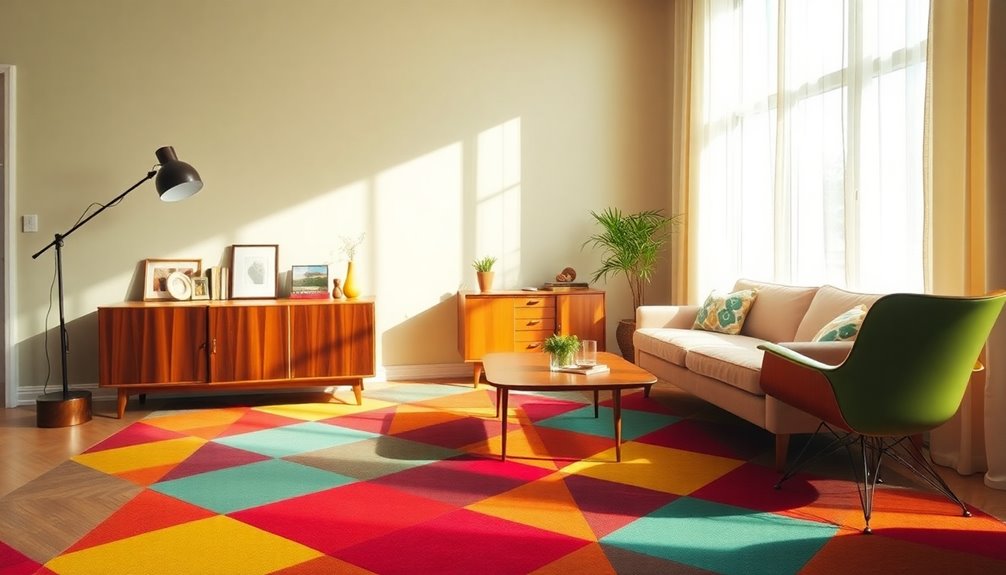
Rugs play a crucial role in mid-century modern design, acting as both functional elements and artistic statements. They help define spaces within open-concept layouts, using bold geometric patterns and abstract shapes to create visual structure.
When you place a rug, aim for at least 30 inches beyond the back of chairs to ensure a seamless integration into the room. These rugs not only delineate functional zones but also enhance cohesion with their vibrant colors like olive green and mustard yellow. Mid-century modern rugs are crafted to complement works of iconic designers, adding a touch of historical significance to your space. Additionally, incorporating natural materials like wool or cotton in your rug choices enhances both comfort and style.
Made from natural materials, they provide texture and warmth while emphasizing clean lines and minimalist aesthetics. A striking hand-knotted rug can even become the focal point, complementing your furniture and artwork beautifully.
Incorporating 60s Style Today
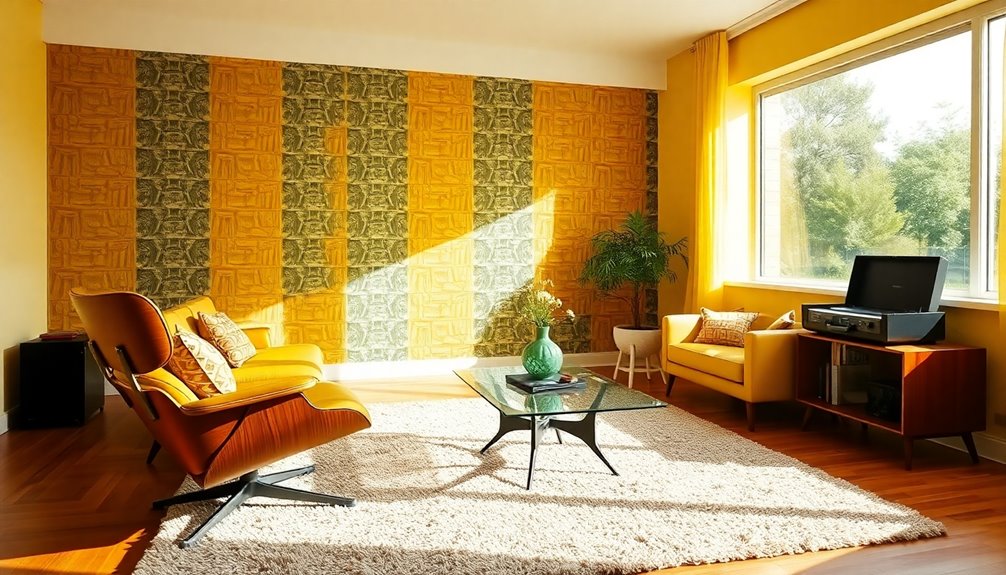
To create a vibrant, retro-inspired space, consider infusing your home with elements that reflect the iconic style of the 1960s.
Start by embracing bright and bold colors like avocado green and tangerine. Mix in psychedelic patterns through wallpaper and fabrics to capture that lively essence. You can also incorporate layered textiles to enhance the visual interest and comfort of the space.
Look for unique furniture shapes—opt for bean bag chairs or a striking tulip table to enhance the playful atmosphere. The trend of multi-purpose furniture became popular during this era, making it easy to find pieces that fit your space while offering functionality.
Don't forget retro lighting; a Sputnik chandelier or a lava lamp can serve as a stunning centerpiece.
Finally, incorporate natural elements with indoor plants and earthy tones to ground the space, creating a serene environment that complements the vibrant decor.
Common Elements of the Era
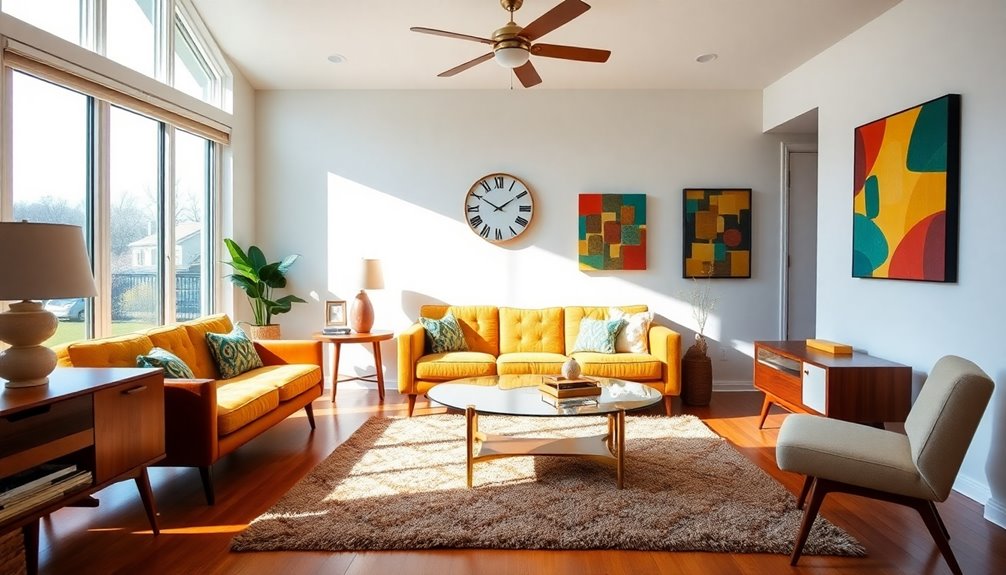
While exploring mid-century interior design, you'll quickly notice several common elements that define the era's distinctive style.
First, functionality reigns supreme; furniture is crafted for both utility and aesthetic appeal, often featuring multifunctional designs.
You'll also see a blend of organic and geometric shapes, with smooth lines and tapered legs creating a harmonious balance.
Minimal ornamentation is key, as designers embrace a "less is more" philosophy that results in uncluttered spaces. This philosophy was notably championed by the Bauhaus school, which emphasized minimalist design and challenged traditional norms.
The era celebrates a mix of materials, combining rich woods with metals and glass for a unique touch.
Finally, color palettes often consist of neutral bases accented by bold hues, ensuring a stylish yet balanced environment.
Each element contributes to a cohesive mid-century modern aesthetic.
Design Tips for 60s Aesthetics
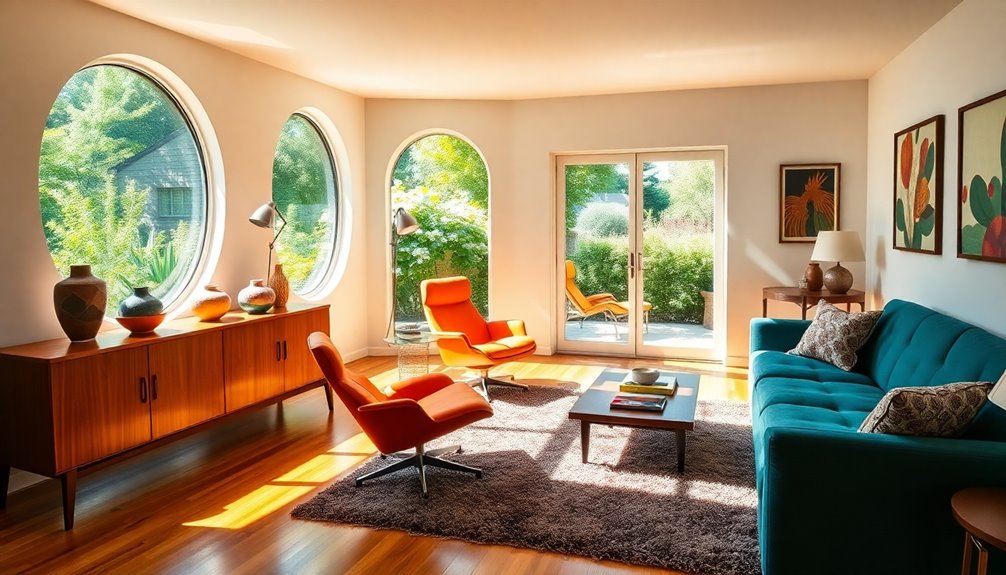
Embracing the vibrant essence of the 60s can transform your space into a nostalgic haven. Start with a color palette that features vivid oranges, yellows, and greens. Incorporate bold hues and graphic color-blocking to make a statement.
Choose furniture with curved shapes and organic forms, like a bright yellow dining table or a shag pile rug for added comfort. Lighting is essential; think lava lamps and Sputnik chandeliers to create focal points. The use of natural materials is also a hallmark of Mid-Century Modern design, enhancing the warmth and authenticity of your space. Additionally, incorporating cozy textiles can further elevate the comfort and aesthetic of your room.
For decorative elements, textured wallpapers and retro accessories, like vintage typewriters and radios, enhance the ambiance. Finally, don't forget iconic patterns, like Orla Kiely rugs, to tie everything together.
With these tips, your home will radiate that classic 60s vibe effortlessly.
Historical Context of 60s Design

As the 1960s unfolded, a whirlwind of social, cultural, and technological changes shaped the landscape of interior design.
You'd see the vibrant influences of the cultural revolution, from civil rights to counterculture, reflected in playful and unconventional styles. The excitement of the Space Race sparked futuristic designs and materials, while post-war optimism brought bold colors and daring patterns into homes.
Innovations in materials like plastic and laminate led to sleek, eye-catching furniture. Pop Art's impact made its way into interiors through geometric and abstract patterns. The era also saw the introduction of molded fiberglass furniture, which contributed to the unconventional shapes that characterized the decade's aesthetic.
Iconic Pieces From the Decade
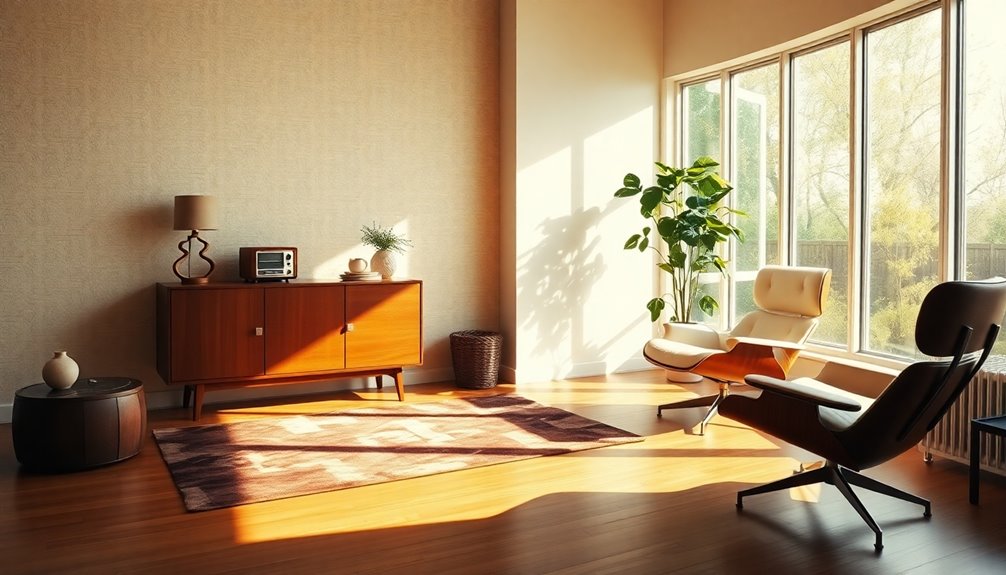
The 1960s produced a stunning array of iconic pieces that defined mid-century interior design and still resonate today.
You'll find furniture with curves, like the luxurious Eames Lounge Chair and the unique Egg Chair, both offering comfort and style. The Tulip Table and Wishbone Chair exemplify elegant designs that blend form and function.
Bold lighting, such as the eye-catching Sputnik Chandelier and colorful Lava Lamp, added a playful touch to spaces. Patterned wallpapers featuring geometric and floral designs transformed walls into art.
Multifunctional furniture, like modular sofas and sleek fiberglass chairs, maximized space while maintaining aesthetic appeal. This emphasis on functionality and practicality is a hallmark of mid-century modern design, showcasing the innovative spirit of the decade. Additionally, the use of durable materials in furniture construction ensured longevity, making these pieces cherished investments for homeowners.
These elements collectively embody the innovative spirit of the decade, making them timeless staples in modern interiors.
Lasting Impact on Modern Interiors
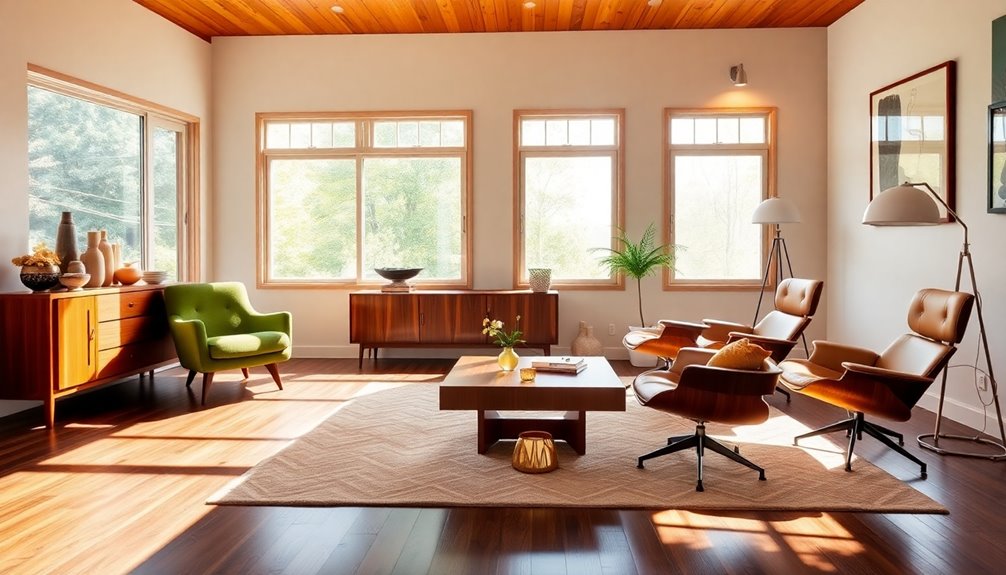
Mid-century interior design has left a lasting imprint on modern interiors, influencing everything from layout to materials.
You'll notice the clean lines and minimalist approach that prioritize function over form, keeping spaces clutter-free and practical. This style promotes ergonomic furniture, enhancing your comfort and usability. Additionally, the innovative use of new materials has allowed for unique design possibilities that appeal to contemporary tastes. Creating an interior design mood board can help you visualize how these elements can come together in your own space.
Moreover, the integration with nature shines through expansive windows and sliding glass doors, seamlessly merging indoor and outdoor spaces.
The use of innovative materials like plastic and metal adds a contemporary touch while maintaining durability and craftsmanship.
Lastly, the focus on human-centered design creates harmonious spaces that cater to your needs, ensuring that mid-century pieces continue to inspire and captivate modern designers. Embracing these elements can elevate your own interior spaces.
Frequently Asked Questions
What Are Some Affordable Ways to Achieve a 60S Design Aesthetic?
To achieve a 60s design aesthetic affordably, start by thrift shopping for vintage pieces at local stores or online marketplaces.
Consider DIY projects like furniture restoration or creating geometric artwork. You can also explore budget-friendly options at retailers like IKEA or Target.
Mix old and new elements for a balanced look, using a neutral base with statement pieces to add character.
This way, you'll capture that nostalgic vibe without breaking the bank.
How Can I Mix 1960S Decor With Modern Styles Effectively?
To mix 1960s decor with modern styles effectively, start by choosing a neutral color palette as your base.
Use vintage furniture pieces alongside sleek modern seating for contrast.
Layer textures like leather and wool, and incorporate vintage patterns for a cozy feel.
Aim for balance by applying the 80/20 rule, keeping 20% vintage items and 80% modern.
This way, you create a harmonious blend that celebrates both eras beautifully.
What Are the Best Colors to Use for a 60s-Inspired Room?
When you're aiming for a 60s-inspired room, think of colors that whisper nostalgia.
Embrace nature-inspired shades like avocado green and deep blues to create a serene atmosphere.
Warm tones like mustard yellow and burnt orange can add a lively touch, while bold hues like turquoise and fuchsia inject personality.
Don't shy away from metallic accents and playful patterns, as they'll bring that charming playfulness of the decade right into your space.
Are There Specific Brands That Specialize in 1960S Furniture Reproductions?
If you're looking for brands that specialize in 1960s furniture reproductions, you've got some great options.
Broyhill offers collections like Brasilia and Sculptra, blending Atomic design with Danish Modernism.
Drexel features clean lines and minimal ornamentation, perfect for a functional look.
Lane Furniture combines unique details like surfboard tabletops, while Kardiel focuses on quality materials and design.
Each brand provides a mix of classic and modern elements to suit your style.
How Has 1960S Design Influenced Contemporary Interior Trends Today?
The influence of 1960s design on contemporary trends is unmistakable.
You'll notice natural materials like wood and rattan making a comeback, along with vibrant colors that reflect that era's bold spirit.
Geometric patterns and organic shapes are prevalent, adding a playful touch to modern spaces.
As you curate your interior, consider mixing eclectic influences, embracing individuality, and incorporating iconic pieces that echo the innovative designs of the '60s for a fresh, yet nostalgic feel.
Conclusion
As you embrace the vibrant essence of 60s interior design, remember to mix bold colors with sleek lines for that groovy vibe. Incorporate statement pieces, like a funky chair or a retro rug, to capture the spirit of the era. By weaving these elements into your space, you'll not only celebrate nostalgia but also create a stylish haven that resonates with today's trends. So, let your creativity flow and transform your home into a mid-century masterpiece—far out!




